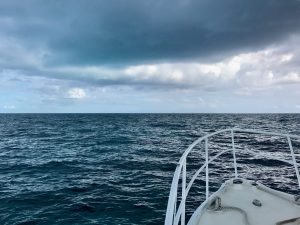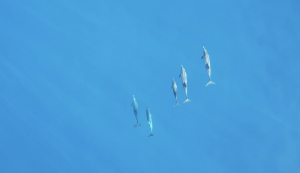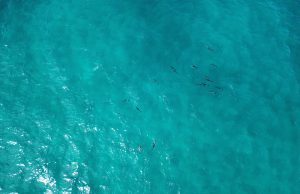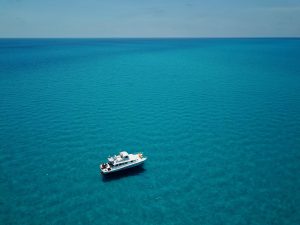As any scientist will tell you, field work is no walk in the park. In our case, the research depends on calm enough weather, a smoothly running boat, and the agenda of wild dolphins. The ocean could be as flat as glass— but if the dolphins aren’t interested in our company, they won’t hang around when we get in the water to record their behavior. That’s just the reality of studying wild animals on their terms! Luckily, they’re often curious about us, tolerating and seemingly enjoying our presence. I decided to step up the field work difficulty a bit more this summer and study their behavior with a bird’s eye view— using my DJI Mavic Pro drone.

Stormy skies off the bow of the RV Stenella— beautiful, but not conducive for flying drones! Photo by Liah McPherson.
Originally, my idea was to focus on groups of traveling dolphins with the hopes of analyzing their group structure, behavior and leadership. However, I overestimated the amount of data I’d be able to collect. On many occasions, the winds were too strong or the sea was too rough. I have to catch the drone out of mid-air in order to land it on Stenella, and I don’t want to cut my hand on the drone’s propellers! Additionally, traveling dolphins are tough to keep track of. By the time we’d gotten out of the water after a quick photo-ID encounter to identify individuals, they had often disappeared.
That being said, I was able to get some incredible footage of traveling and behaving dolphins. The bird’s eye view offers a perspective we’ve never had before, and the ability to study group dynamics with high accuracy. Moreover, the Mavic Pro’s 4K video provides enough detail that I can identify individual dolphins as I’m flying and during video review— this is a huge benefit for answering specific questions pertaining to dolphins’ age, sex or lineage.

In glassy conditions, I can identify the individuals— here, from left to right, we have Venti, Flotsam, Nala, Naia and FlyingA. Photo by Liah McPherson.
I may not have collected enough data to adequately begin answering these research questions, but I have enough to write a baseline methodology paper on the use of drones for studying wild dolphin behavior. For now, during the off season, I’ll be writing that paper for my senior honors thesis at the University of North Carolina and Chapel Hill. During the next few field seasons, I’ll keep flying my drone to build up a bigger video database. How does group structure change as dolphins travel over new habitats or in response to threats? Are dolphins of a certain age or sex more likely to be leaders in traveling groups? Are there behavior signals for direction changes? Ask me again in a few years!
Thank you to my Wild Dolphin Project crew and to our wonderful colleagues and passengers— It’s been another terrific summer studying these fascinating animals in their world. I’m already looking forward to the 2019 field season!
By Liah McPherson
Wild Dolphin Project, Undergraduate Field Assistant


